October Mushroom of the Month: Omphalotus subilludens





The October mushroom of the month is Omphalotus subilludens commonly known as Southern Jack-o-lantern. We thought this one was an easy one but many of you guessed it was a chanterelle which is edible and the southern jack-o-lantern is toxic. Scroll to learn the differences and more about how this mushroom glows in the dark like a jack-o-lantern.
🙌 to @erociovergara for naming that mushroom correctly and becoming the 1,174th member of Central Texas Mycology!
Can I Eat It?
NO! It’s toxic!
It won’t kill you but you will wish you were dead. It contains the toxic chemical illudin that can cause severe stomach upset, vomiting, diarrhea and headache. A real nightmare on Elm Street. It gets commonly confused with the choice edible, chanterelle.
CHANTERELLEs
Mycorrhizal: Grows typically as a single mushroom in symbiosis and within several feet of living Live Oak trees.
Gills: False or folded and run down the stem (decurrent).
Stem: When peeled, pale orange on the inside
Season: Spring and Fall during high humidity like after Texas style flash floods.
Southern Jack-o-Lantern
Saprophytic: Decomposes and fruits in clusters at base of stumps or buried roots.
Gills: True, sharp, non-forking gills that are decurrent or adnate (like shown above).
Stem: bright to dark orange on inside
Season: Spring and Fall after rains.
IT Glows in the dark!
Bioluminescence, a blue-green color, can be seen in the gills of fresh specimens in low light once the eye becomes dark-adapted or with long exposure photo-graphy. This is due to the enzyme luciferase, acting upon a compound called luciferin, leading to the emission of light similar to the way fireflies do when glowing. Scientists have found the glow attracts insects that then spread the mushroom spores.

